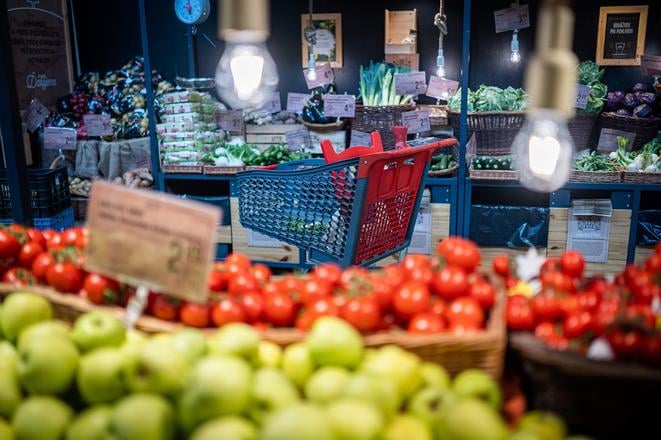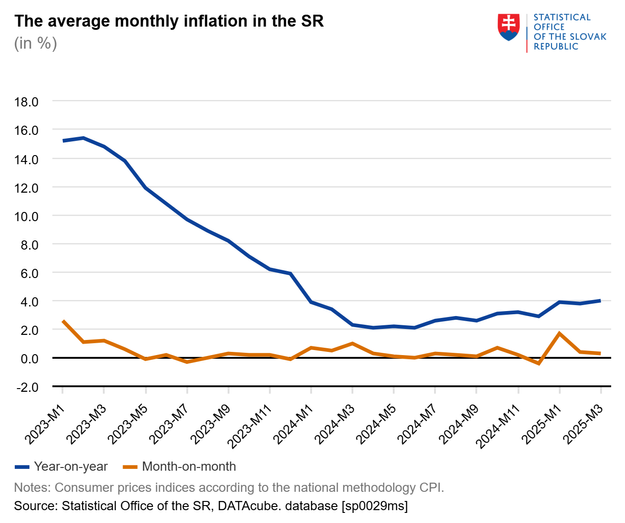Inflation in Slovakia reached its highest level in over a year in March, driven largely by a broad-based increase in prices for services and essential goods. Annual inflation rose to 4 percent, according to data released by the Statistics Office, marking the sharpest increase since the end of 2023.
The most significant contributors to the month-on-month rise were prices in restaurants and hotels, which climbed by 1.5 percent overall. Dining services saw increases of 2.3 percent in canteens and 1.1 percent in restaurants and cafés. Accommodation prices also rose by 1.2 percent.
Analysts say this resurgence in inflation comes before businesses have fully factored in the government’s new financial transaction tax, suggesting that price pressures could intensify further in the coming months.
“This increase was relatively broad-based across the consumer basket,” said Ľubomír Koršňák, an analyst at UniCredit Bank. “But above-average inflation remains particularly visible in services, where labour costs form a large part of the final price.”
Indeed, services—especially in hospitality and personal care—saw the fastest year-on-year growth. Restaurant and hotel prices rose by more than 9 percent, even after a VAT cut in January. Hairdressers and veterinary services recorded even steeper increases, despite also benefiting from lower VAT.
Retail goods have yet to fully reflect higher VAT rates. “We assume much of the tax rise has so far been absorbed in profit margins,” said Matej Horňák of Slovenská sporiteľňa, adding that goods prices are expected to rise later this year, further fuelling inflation.
Inflation outlook darkens despite food and fuel relief
Food prices increased by 4.1 percent compared with March 2024, particularly due to higher costs for milk, eggs and flour-based products. However, Koršňák noted that food prices have recently had a more neutral impact on overall inflation, with seasonal trends even nudging some prices down. Still, because prices were falling more steeply a year ago, the comparison now shows a sharper rise.
Meat prices bucked the trend, falling by 2.6 percent year-on-year, even as foot-and-mouth disease forced the culling of thousands of cattle. The National Bank of Slovakia’s Branislav Karmažin believes the outbreak will have only a limited medium-term impact on inflation due to the dominance of EU-wide pricing and supply chains.
Fuel prices also provided relief, dropping by nearly 10 percent year-on-year thanks to weaker global oil prices. Energy subsidies continued to cushion households from market volatility, with the state reimposing price caps on gas and heating.
Clothing and footwear prices, which had fallen earlier in the year, jumped by 1.7 percent in March. Housing and utility costs increased modestly by 0.2 percent, driven by higher costs for maintenance, waste collection and solid fuels. District heating prices edged down.
While Eurostat’s harmonised index shows Slovak inflation at 4.3 percent in March—up from 4.1 percent in February—analysts believe further increases are likely. “We expect year-on-year inflation to accelerate further due to the transaction tax,” said Horňák. “It could peak around 4.5 percent during the summer.”
The Finance Ministry’s Institute for Financial Policy had forecast 4.1 percent, but the official figure came in just below that. Even so, the central bank has revised its inflation outlook upwards, citing stronger-than-expected increases in some services and regulated prices.
Easter baking gets pricier
Prices for ingredients essential to home baking ahead of Easter are also pushing higher. Cocoa prices rose by 67 percent in February, driving up the cost of chocolate, with one brand of cooking chocolate up 55 percent year-on-year. Butter, once the subject of political debate, remains around 30 percent more expensive than a year ago.
Although dairy products benefit from a reduced VAT rate, their prices remain high. Milk was up 7 percent year-on-year, while vegetable oils and fats climbed more than 13 percent, marking the ninth consecutive month of double-digit growth. Eggs also became more expensive, in part due to bird flu outbreaks across Europe, including in Poland, Italy and the United Kingdom.
Despite these pressures, Koršňák insists food prices overall are no longer a major inflationary force. Yet as the effects of tax changes spread and external risks linger, Slovakia may remain one of the eurozone’s inflation hotspots for months to come.


 Year-on-year inflation reached 4 percent, the highest level since December 2023. (source: Sme - Marko Erd)
Year-on-year inflation reached 4 percent, the highest level since December 2023. (source: Sme - Marko Erd)
 Consumer prices for goods and services rose by 0.3 percent month on month in March, marking a slower pace than in the previous two months. Year-on-year inflation reached 4 percent, the highest level since December 2023. (source: Statistics Office)
Consumer prices for goods and services rose by 0.3 percent month on month in March, marking a slower pace than in the previous two months. Year-on-year inflation reached 4 percent, the highest level since December 2023. (source: Statistics Office)